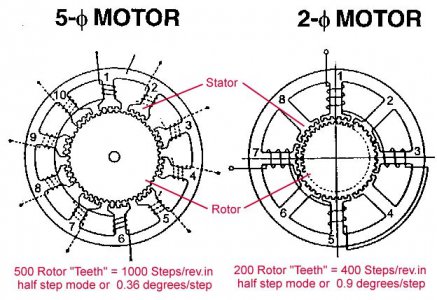If it has 5 wires, that sounds like a unipolar stepper motor. They're the easiest to drive. Simply find that wire that reads a resistance to all of the other ones. That's the common. That can be tied to your supply voltage (or to ground). The remaining four wires are connected to the other supply (+ or ground depending on what you've connected your common wire to). Each wire get's connected (only one at a time) 1,2,3,4 to the other supply to step the motor. Doing the same thing 4,3,2,1 runs the motor the other way.
A 5 wire motor (really only 4 phases) is the same as a 6 wire motor except two wires are connected internally to bring 5 out.
See here.
http://www.stepperworld.com/Tutorials/pgUnipolarTutorial.htm
The other main type (apart from three phase steppers - not normally seen in commercial applications) is the Bipolar (AKA two phase, sine-cosine, or 4 wire stepper motor). These need to commutated by connecting each wire to positive or negative in a specific sequence. This is normally done with a circuit called an H-bridge. Bipolars offer the advantage of more torque in a given size, and the ability to be microstepped. Microstepping offers the ability to position the motor in between detents (as long as power is on).
Unipolars can not be microstepped easily if at all. They are also larger for a given torque because only 1/4 of the available copper is used at any time. There is a way to get 1.4 times the torque, but the motor will step in between detents and power must be retained to maintain position. The big advantage to unipolars is the ease of commutation.
My company designs and builds custom brushless DC and stepper motors for space applications and I design the motion controllers for these radiation filled environments. Stepper motor drivers and applications are my area of expertese.
If it has 5 sets of windings (ten wires) that's a horse of a different color. It could actually be a 5 phase motor (VERY uncommon) or two unipolar motors sharing one rotor. These can be used individually for reliability by redundancy or connected in parallel or series for higher voltage or higher current applications (usually seen only with Biploar motors)
John

